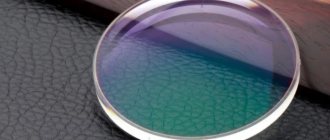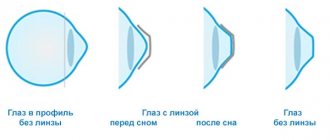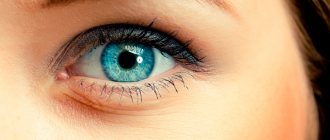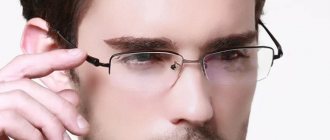Educational program on spectacle lenses. (Part I) L.A. Alekseeva
Modern spectacle lenses are significantly different from the lenses offered to visitors to optical salons 10 years ago. The requirements for glasses have changed. Today, for many people, glasses are not only a means of vision correction, but also a product that emphasizes their image and decorates their face. Spectacle lenses made of various materials, different designs and designs, with strengthening, protective and anti-reflex coatings, have appeared on the domestic market. Today, a sales consultant has a lot of responsibility. The successful operation of Optika stores and showrooms largely depends on his professionalism. Sales consultants must provide the buyer with all the information about spectacle lenses, explain the features, advantages and disadvantages of various types of lenses, while it is necessary to understand their properties themselves. The action of spectacle lenses is subject to the laws of geometric optics, the main of which are the laws of reflection and refraction. In several publications we will try to present in an accessible form the available information about modern spectacle lenses. Let us recall the classification of spectacle lenses. Spectacle lens – designed for vision correction. Characterized by optical power, expressed by refraction. The unit of refraction is diopter (dopter). The following classification of spectacle lenses has been adopted in accordance with GOST R 51044-97 “Eyeglass Lenses”, which takes into account the indicators and requirements of the international standard ISO8980-1-92. Spectacle lenses are divided: – according to the number of optical zones into: O – single vision B – bifocal T – trifocal – if possible for the correction of vision defects on A – astigmatic C – stigmatic – if possible with the correction of strabismus and heterophoria on P – prismatic – non-prismatic – according to the sign of the back vertex refraction (F' v) to – positive – negative – negative-positive depending on the presence of a lenticular chamfer L- lenticular and non-lenticular (not designated) – according to manufacturing technology on – glued K – sintered C – solid (not designated) – according the presence of a plane of symmetry - for correction of the right eye 1 - for correction of the left eye 2 - depending on the position of the optical center relative to the geometric one - centered - decentered The packaging envelope with a spectacle lens (according to GOST 51044) must contain: - type of lens - technological design (sintered C ; glued K) – the presence of a lenticular chamfer L – for correction of the right or left eye (1; 2) – value of the useful diameter – performance group (depending on the indicators of appearance and manufacturing accuracy (I or II) – normative values of the main parameters – designation of the standard. Examples of designations on packaging envelopes: AP – afocal prismatic lens OS +3.0; o68,II – single-vision stigmatic lens with posterior apical refraction +3.0 diopters, diameter 68 mm, II group OSP +3.0; 3.0″; 60.II – single-vision stigmatic prismatic lens, prismatic action in the nominal center 3.0 prismatic diopters, with a diameter of 60 mm, II group OA -3.0; -1.0 64.II – single-vision astigmatic lens with posterior apical refractions in the I main section -3.0 diopters, in the II main section -1.0 diopters, diameter 64 mm, group II BS +1.0/+3.0; 60.II – bifocal stigmatic lens with posterior apical refractions in the distance zone +1.0 diopter, in the near zone +3.0 diopter, diameter 60 mm , II group BSS 1 +1.0/+3.0; 60/24; 65.II – bifocal stigmatic sintered lens for correction of the right eye with posterior apical refractions for distance +1.0 diopter, for near +3.0 diopter, diameter 60 mm , the size of the zone for near is 24 mm, with a diameter of 65 mm, group II BA –2.0; -1.0; 60o - 0.0; +1.0; 60o – bifocal astigmatic lens, having in the distance zone the rear vertex refractions in the first main section -2.0 diopters, in the second main section -1.0 diopters, the direction of the first main section is 600; in the near zone - rear apical refractions in the first main section are 0.0 diopters, in the second main section +1.0 diopters, the direction of the first main section is 600 (the prescription for this lens is given below). Sph –2.0 Cyl +1.0 ax 60o Sph 0.0 Cyl +1.0 ax 60o Spectacle lenses widely used today in foreign countries must comply with the standards developed in these countries. For example, European standards: EN 166,167,168 (1994-2001) GOST R 51044-97 “Eyeglass lenses” General technical conditions apply to spectacle lenses made of colorless inorganic glass and polymer material intended for vision correction. *(Educational program – elimination of illiteracy, mass education of the population in literacy). To be continued. Published with permission from L. A. Alekseeva
SEIKO AZ 1.60 astigmatism lenses guarantee unsurpassed vision quality
Patients diagnosed with astigmatism, when choosing new lenses for their glasses, first of all need to pay attention to SEIKO bi-aspheric lenses (double aspherics). The specially developed design provides fantastic vision quality compared to conventional “spherical” and even “aspherical” lenses. We present to your attention thin, light and fairly affordable bi-aspheric lenses - SEIKO AZ 1.60 SCC. A special design for astigmatism correction, thin and durable material, premium multi-coating on both sides - makes these spectacle lenses an ideal option for creating medical glasses with aesthetic properties.
Go to the page “SEIKO AZ 1.60 spectacle lenses”.
In 1998, the Japanese company SEIKO Optical first introduced to the world a completely new design of traditional glasses lenses with an aspherical surface on both sides of the lens (double aspherics), which immediately won universal recognition among users with astigmatism. The wearer of medical glasses with bi-aspherical design lenses can be completely free from distortion in all areas of the lens, right down to the very edges. An additional visual and aesthetic quality of these lenses is the almost complete absence of the effect of “intrinsic lens magnification,” when eyes at high diopters do not naturally increase or decrease depending on the diopter.
This design excels at eliminating distortion when correcting astigmatism, maximizing the areas of clear vision. It should be noted that among all the possible designs of traditional lenses, it is double aspherics that provides the highest possible quality. The SEIKO AZ design is just a kind of “Mercedes” in spectacle lenses. Users switching from spherical to bi-aspheric lenses experience an extraordinary "wow" effect due to the significantly larger fields of clear vision in the new glasses.
The proprietary lens base material - Super Luscious with a high refractive index n=1.60 allows you to install SEIKO AZ 1.60 SCC lenses in any frame, including rimless ones (with screws or on a fishing line). The high ABBE number of 42 completely eliminates the formation of chromatic aberrations when viewed off-axis through such lenses. And the material's own 100% protection from harmful UV rays (up to 395) completely protects the user's eyes, allowing the lenses to be tinted any color without worrying about the transmission of UV rays into wide-open pupils due to sun-protective tinting.
Most diopters are available to order with quick installation into the frame. You can choose between SEIKO SuperCleanCoat (SCC) and SEIKO SuperResistantCoat (SRC). We also recommend that you familiarize yourself with photochromic lenses SEIKO AZ 1.60 Transitions, with the property of rapid darkening in the sun and brightening indoors.
Photo: seiko-optical.de
Consultants at the Contrast optical salon are familiar with the variety of designs and help you make the right choice of lenses for glasses. In our salons there is always a large selection of lens designs from the world's leading manufacturers.
Optics salon "Contrast" presents lenses:
- lenses for Nikon glasses;
- BBGR glasses lenses;
- Supralite glasses lenses;
- Carl Zeiss glasses lenses, as well as other brands of glasses lenses.
Spherical lenses for glasses.
The simplest and most accessible design of spectacle lenses is spherical. There is a rule by which the curvature of spherical surfaces is selected (depending on the refractive index of the material and the optical power of the lens) in order to ensure minimal visual distortion.
Toric lenses for glasses.
A cylindrical surface with a curved axial meridian is called toric. A toric lens has two radii of curvature (the radius of the cylinder and the radius of the curved axial meridian). Toric lenses are used to correct astigmatism. Visually, such a lens can be distinguished from a spherical lens by the thickness of the edge of the round blank; for a toric lens, the thickness varies along the perimeter.
Aspheric lenses for glasses.
Any shape of the surface of revolution other than a sphere is called aspherical. The most well-known aspherical surfaces are the ellipsoid, hyperboloid and paraboloid. The curvature of such surfaces changes with distance from its apex. This makes it possible to effectively correct distortions inherent in conventional spherical lenses at high diopters. In this case, the aspherical lens turns out to be flatter. It should be remembered that the quality effect of an aspherical lens may be lost if it is incorrectly positioned relative to the eye (incorrect insertion into the frame).
Progressive lenses for glasses.
In adulthood, usually over forty years, every person experiences discomfort when reading or looking at close objects. If he didn’t wear glasses, he would definitely buy them for reading; if he did, he would realize that he needs others. This phenomenon in medical language is called presbyopia and is associated with a natural deterioration in the elasticity of the eye lens.
Until recently, the problem was solved with the help of additional reading glasses or so-called bifocal glasses, in which the zones for far and near vision are separated by a visible border. The inconveniences of such solutions are obvious: you either constantly look for second glasses, or put up with the unsightly appearance of bifocals and the fact that objects at medium distances are inaccessible for clear vision.
But there is a solution to the problem of presbyopia. The whole world has been using glasses with progressive lenses for several decades, in which the optical power changes smoothly. In Russia, such lenses began to appear in the nineties of the last century, but did not become actively widespread due to the lack of qualified specialists in most optical shops who could work with such lenses. In the last few years the situation has changed. Leading optical manufacturers have done a lot of work to retrain doctors, technicians and consultants of Russian opticians.
The “Contrast” optics salon was the first in Yekaterinburg to begin making glasses with progressive lenses and has already accumulated vast experience in working with optics from leading manufacturers.
Office lenses for glasses.
Office lenses are special lenses that have an enlarged reading area and an intermediate area for working at a computer. This is achieved by excluding the distance zone. At the same time, it becomes possible to work more comfortably at short distances (in the office).
Contact the Contrast salons, where you will be provided with qualified assistance in selecting glasses of various designs and will answer all your questions!
Medical website Surgeryzone
Despite the enormous popularity of various refractive surgeries, the undoubted and obvious advantages of contact lenses are obvious. Various lenses can be selected here.
If we look at history, the use of glass lenses to improve vision was first invented by Venetian glassmakers at the end of the 13th century. By the middle of the 15th century, after Gutenberg invented the printing press and reading books became a popular activity, glasses became quite widespread.
Glasses are an optical device consisting of a frame and lenses. Currently, opticians offer a fairly large assortment of spectacle frames and lenses, produced taking into account fashion requirements.
Classification of spectacle lenses
I. Classification of lenses according to optical effect:
Stigmatic (spherical) lenses move focus along the optical axis. Both of their refractive surfaces are spherical. In all meridian sections, such lenses have the same refractive power, which is determined in diopters.
Astigmatic lenses change the shape of the convergence of the rays. One of their refractive surfaces is toric, the other is spherical. In two mutually perpendicular (main) sections they have different refractive powers.
Afocal (eikonic) lenses reduce or enlarge the image. Both spherical surfaces of such lenses have the same radius, but one of them is concave and the other is convex. These lenses have no focus and therefore cannot form images. The eikonic effect is measured as a percentage, and at high magnifications - in multiples. Prismatic lenses move focus perpendicular to the optical axis. A prism is a narrow wedge made of transparent material. Prismatic action is measured in prismatic diopters or centiradians.
II. Classification of lenses by focus position (only for stigmatic and astigmatic lenses): Collective (positive, convex). The main focus of such lenses is behind the glass. Scattering (negative, concave). The main focus is in front of the glass. III. Classification of lenses by surface shape: Spherical. Classical lenses, the front and rear refractive surfaces of which can be described by a spherical radius. Aspherical. The front (base) surface (and sometimes the back) deviates from the shape of a sphere. Lenticular. Only the central optical zone of such lenses has the necessary optical power and is working, while the periphery serves only as its basis and is made thin enough for the lens to look aesthetically pleasing.
IV. Classification of lenses according to the combination of refractive surfaces: Bi-shape (both surfaces are convex or concave). Plan-forms (one surface of the lens is flat, the other is convex or concave). Menisci (one surface of the lens is convex, the other is concave).
It must be said that at present, menisci are mainly used, since in bi- and plan-forms the astigmatism of oblique beams is quite large (the astigmatic effect of any spherical lens if the rays fall on it at a large angle to the optical axis).
V. Classification of lenses according to the number of optical zones:
Single vision lenses have only one optical zone. Multifocal - two or more. They are used to improve the clarity of perception of objects located at different distances with weakened accommodation. Multifocal lenses are divided into:
A. Lenses with step change in refraction:
• Bifocal. • Trifocal
B. Transfocal (variofocal) lenses. They have a smooth transition between zones of different optical effects.
VI. Classification of lenses by light transmittance: Made of colorless glass. Painted in mass (made from colored glass). Surface painted (organic). Photochromic.
VII. Classification of lenses by material:
1. Mineral lenses.
2. Organic lenses are made from polymer materials and are divided into:
A) made from thermosets, which are characterized by increased abrasion resistance;
B) made of thermoplastics (polycarbonate), the distinctive property of which is high resistance to impact loads;
B) made from quasi-reactive plastics (TMuex material), occupying an intermediate position between thermosetting and thermoplastics and combining the advantages of the first two types of organic materials.
You cannot definitely give preference to either plastic or glass. There are excellent quality products available today, each material has its own advantages and disadvantages.
VIII. Classification of lenses by refractive index: Traditional, medium and highly refractive lenses. IX. Classification of lenses according to the type of optical coatings used on the surfaces of the lenses: Sun protection.
Mirrored. Anti-reflective (anti-reflective, anti-glare). Multifunctional coatings (multi-layer, multi-coating). The article was prepared and edited by: surgeon I.B. Pigovich.
Video:
Healthy:
Related articles:
- Preferences of consumers of spectacle lenses Particular attention when choosing spectacle lenses is paid to comfort and convenience, aesthetics and price. Just lenses...
- Toric contact lenses According to published data, about 30% of patients with ametropia have astigmatism of 0.75 D and above...
- Treatment of corneal diseases using soft contact lenses Among all pathologies of the organ of vision, diseases of the cornea of the eye (COG) occupy one of the leading places...
- Should I do a puncture for sinusitis? To do or not to do a puncture for sinusitis? The question is almost rhetorical these days...
- Endermology (LPG massage) Endermology or LPG is a type of massage, a method of figure correction and skin tightening. The massage is performed with a special…
- Surgical treatment of obesity and metabolic syndrome - a study Obesity is an acute problem in modern society. According to WHO, about 30% of the world's inhabitants are overweight...
Economics of Pharmacy Organization of Pharmacy Activities
Classification of spectacle lenses:According to the number of optical zones for correction of ametropia vision:
- afocal;
- single vision(O);
- bifocal(B);
- trifocal(T).
If possible, correction of visual defects with astigmotism:
- stigmatic(C);
- astigmatic (A).
Possible visual defects due to strabismus and weakness of the eye muscles:
- prismatic(P);
- non-prismatic.
According to the sign of the vertex refraction value:
- positive(+);
- negative(-);
- negative - positive.
Based on the presence of a lenticular chamfer:
- lenticular(L);
- non-lenticular.
According to manufacturing technology: glued (K), sintered (C), solid.
According to the presence of a dimensional plane: lenses for correction of the right eye (1), lenses for correction of the left eye (2).
According to the nominal position of the optical center relative to the geometric one: centered, decentered.
By quality: groups (1 and 2).
Materials for making spectacle lenses.
Spectacle lenses are made from blanks of colorless or inorganic, as well as from organic materials - polycarbonate, Trivex, etc.
To improve the properties of spectacle lenses, various coatings can be applied to them: strengthening, anti-reflective, hydrophobic, anti-computer, multifunctional.
Requirements for the quality of spectacle lenses
Composition and properties of raw materials
Corresponding refractive indices (1.47 - 2.04) and dispersion coefficient (70 - 78) of glass
Lens clarity
Lens surface cleanliness
Proper quality of processing of refractive surfaces of lenses
No deviations in the shape of the lens surface that distort the image of the object in question
Depth of chips within the useful diameter (no more than 1 mm)
Width of scratches and their total length (no more than the established values)
The height of the ledges at the vertices of the dividing line of zones for distance near bifocal solid lenses (no more than 0.3 mm)
Absence of streaks within the useful lens diameter
Number of bubbles, dots and other foreign inclusions (standardized)
Lens decentration (within normal limits)
Availability of symbols showing the optical center of lenses and the main sections of astigmatic and prismatic lenses
Resistance to climatic influences during operation.
Packaging and labeling of spectacle lenses
Each lens is placed in a paper packaging envelope or plastic packaging, which contains the following information:
- Trademark of the manufacturer
- The inscription “spectacle lens”;
- Nominal lens diameters;
- Nominal values of the main parameters of the lens;
- Designations of the type and design of the lens;
- Standard designation
The lens designation must contain:
- The inscription “spectacle lens” and the designation of the lens type;
- Designation of technological design (K or C)
- Indication of the presence of a lenticular chamfer (L)
- Designation of correction of the left or right eye (1 or 2);
- Group designation (1 or 2);
- Designations of main parameters.
In order to better recognize packages of different types of lenses, the envelopes are marked with appropriate color stripes: for single-vision stigmatic lenses - blue, single-vision astigmatic - green, bifocal astigmatic - red, others - brown.
Storage of spectacle lenses in pharmaceutical and optical organizations.
It is carried out in clean heated and ventilated (air-conditioned) rooms. Air temperature – from +5 to +40 °C, relative air humidity 80% at 25 °C.
Lenses are stored in secondary group packaging by type, type, design, group, size, color, etc.
general information
Spectacle lens– an optical lens designed for vision correction, to protect the visual organs from ultraviolet and solar radiation, to correct visual impairments and other purposes. In connection with recent advances in the field of spectacle optics, the technological process of their manufacture has also changed. Unique materials for spectacle lenses have been developed: glasses with a high refractive index, capable of blocking the maximum possible share of ultraviolet radiation, new types of organic glass. There has been an increase in the consumption of lenses with various shapes - aspherical, lenticular, progressive; with various special coatings and their combinations; lenses with varying degrees of light transmission - photochromic lenses (gray, brown).
To ensure that the lens becomes thinner, lighter and more beautiful, and more clearly and completely conveys information about the surrounding world, new types of lenses are constantly being developed.
There are three main groups of characteristics that determine the physical properties of lenses: the properties of optical materials, the design of the lenses, and the properties of the coatings applied to the surface of the lens.
Classification of spectacle lenses:
1
According to the number of optical zones of vision correction
:
- afocal,
- single vision,
- multifocal.
Afocal
– lenses that have no optical power. Used, for example, in sunglasses and computer glasses.
Single vision
– have one optical coverage area.
Multifocal
– have two or more optical action zones. They are divided into transfocal, i.e. with smoothly changing transitions of optical action zones (progressive) and with stepwise changes in refractions (bifocal, trifocal and quadrifocal). Multifocal lenses are used to clearly see objects at different distances.
2.
According to the spatial homogeneity of vision correction
:
- stigmatic,
- astigmatic.
Stigmatic –
lenses, both refractive surfaces of which are spherical. These lenses have the same refractive power in each meridian section. The refractive power of lenses is determined in diopters.
Astigmatic –
lenses, one surface of which is toric, the other spherical. Astigmatic lenses in two main sections perpendicular to each other have different refractive powers. Designed to correct astigmatic vision.
According to the position of the main focus, stigmatic and astigmatic lenses are divided into positive, prescribed for farsightedness, and negative, for myopia.
3.
According to the shape of the refractive surfaces of the lenses, they can be
:
- spherical,
- aspherical,
- lenticular.
Spherical –
a lens bounded by two spherical surfaces.
Aspherical –
lenses in which the base surface cannot be described by a spherical radius, that is, it deviates from the shape of a sphere. Due to this, aspherical lenses are thinner and lighter than spherical ones.
Lenticular
– lenses in which only the central optical zone has the necessary optical power, the peripheral zone serves as its basis. The lenticular design allows you to significantly reduce the thickness and weight of the lenses, which gives your glasses a more aesthetic appearance.











